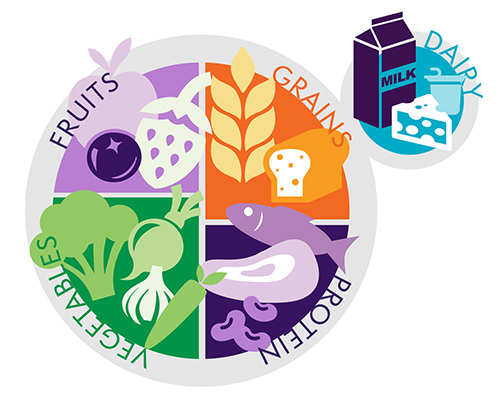When you picture a balanced diet, does the food pyramid come to mind? Many Americans are familiar with the colorful, multi-level image that shows the nutritional categories of foods we should eat every day as part of a healthy diet. Keep reading for a breakdown of the five groups. Plus, get the recommended proportions based on dietary guidelines.
History of the food pyramid
Before World War II, Americans created meals without much advice about nutrition from the government. In 1942, food was rationed during the war. The United States Department of Agriculture (USDA) published nutritional guidelines. These guidelines helped people understand how to eat a healthy diet during this time.
Since then, dietary guidelines have evolved. New research has shown how good nutrition can help Americans lead healthier lives. Check out these food pyramid fun facts:
- The USDA created the first nutritional guidance chart in 1943. The chart was actually a wheel. It included seven food groups. Vegetables were broken down into colors. One group was the “green and yellow vegetable” group. Another was the “oranges, tomatoes and grapefruit” group.
- By 1955, the number of food groups had been narrowed down to four, combining fruits and vegetables into one. The other three were milk, meat, bread and cereal.
- The government launched the first food pyramid in 1992. This new design grouped foods into six categories. It included daily recommended servings for each food group. Fruits and vegetables were broken into their own categories. The pyramid design helped show the volume of each food to eat each day. It started with 6-11 daily servings of grains at the bottom. It ended with sweets and fats to be eaten "sparingly" at the top.
- The 2005 version of the food pyramid, known as MyPyramid. It did away with serving numbers. Instead, it showed the categories as ratios to each other. The biggest change was that this version included exercise in the graphic. This helped reinforce that a healthy diet needs to be paired with physical activity.
- The USDA replaced the pyramid design in 2011 and introduced MyPlate. It's a simpler approach that uses a picture of a plate. It helps show the food groups that should be eaten at each meal in a more visual way.
Healthy eating habits
Just like the food pyramid, our understanding of healthy eating has evolved over time. Dietary needs differ based on age, sex, health and level of physical activity. But some current guidance is the same for almost everyone:
- Eat whole foods — versus processed foods — because they’re best for your body
- Make fruits and vegetables a focus of your daily intake
- Choose whole grains over processed grains
- Eat a variety of proteins including lean meats like chicken and fish and plant-based proteins including beans, legumes, and nuts
- Limit sweetened drinks like soda and juice
- Enjoy occasional sweets and treats
Preventing and managing chronic disease
Research has shown a tie between developing chronic diseases and poor diet. Some people may be overweight and have a body mass index (BMI) outside the normal weight/health weight range. These people are more likely to develop a chronic disease. This can include high blood pressure, diabetes and heart disease. Poor nutrition is the leading cause of illness in this country.
The key is to combine more nutritious options with regular exercise. This is a crucial step to maintaining one's overall health. It has been years since the food pyramid was first introduced. Since then, nutritional science has helped shape our view of a balanced diet. It has shown how vital it is for more people to have access to healthy food. We now know how much it can improve their quality of life.
Mom’s Meals® can help
Nutrition and wellness are at the core of Mom’s Meals. We have professional chefs and dietitians who create nutritionally tailored meals to support better health. Are you or a loved one you’re caring for looking for the convenience of great tasting, ready-to-heat-and-eat meals? We offer meals from nine different health condition menus delivered right to your home. Plus, you can choose every meal in every delivery.



